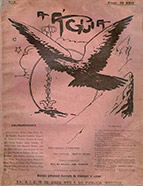

................................
Initially presented as a “fortnightly illustrated magazine of literature and criticism,” and later, from the second series onwards, as a “monthly magazine of Literature, Art, Science, Philosophy, and Social Criticism,” A Águia can be examined from various perspectives, including a historiographical one. In addition to serving as a valuable resource for studying Portuguese artistic and cultural production, particularly in literature, this multidisciplinary publication offers deeper insights into prominent figures in contemporary Portuguese thought, such as Teixeira de Pascoaes, Leonardo Coimbra, and António Sérgio, each of whom interpreted Portugal's past and future in unique ways.
Published between 1 December 1910 and May/June 1932, A Águia had five series. The first series, directed by Álvaro Pinto, comprised ten issues (December 1910 – July 1911). The second and most significant series, led by Teixeira de Pascoaes, ran from January 1912 to October 1921, totalling 120 issues. The third series (1922–1927), directed by Leonardo Coimbra, included sixty issues. The fourth series, published between January 1928 and December 1929, consisted of twelve issues and had various directors, including Hernâni Cidade, Leonardo Coimbra, Teixeira Rego, and António Carneiro. A brief fifth series appeared from January to June 1932, with Leonardo Coimbra, Sant'Anna Dionísio, Aarão de Lacerda (from the second issue onwards), and Delfim Santos as directors. This republican-oriented periodical aimed primarily to contribute to the creation of a renewed Portugal. Until July 1911, when it was dedicated to the poet António Nobre, A Águia , which had not yet become the organ of the Portuguese Renaissance, set itself apart by publishing previously unpublished Portuguese poetry and prose, as well as literary criticism that helped outline the literary landscape of the period. The magazine's interests extended beyond domestic production, as evidenced by the inclusion of articles on foreign artistic and literary themes throughout the first series’ ten issues. In Issue no. 2, for instance, Veiga Simões, Teixeira de Pascoaes, and Sampaio Bruno dedicated texts to the recently deceased Tolstoy. In the following issue, from January 1911, where Miguel de Unamuno began collaborating with the magazine, Sampaio Bruno contributed an essay on the reception of Galileo in Portugal. To illustrate, in the sixth issue, Pascoaes published an article on Victor Hugo, while Reis Machado focused on “Fichte and the German Renaissance.”
This work is financed by national funds through FCT - Foundation for Science and Technology, I.P, in the scope of the projects UIDB/04311/2020 and UIDP/04311/2020.
